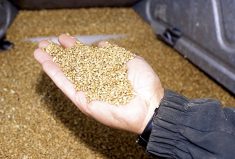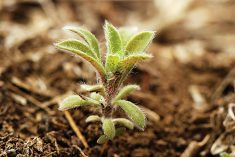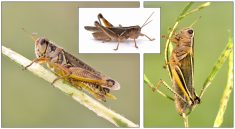For greenhouse crop growers, moving away from chemical pest control to biological controls can be a big investment — but one that’s worth it, if done right.
“You have to change your mindset from pesticides to biocontrol,” said Veronica Cervantes, technical adviser at Biobest USA.
“The first year you start your biocontrol program is the toughest one. It’s what we call the transition year. It’s the most expensive year and the most challenging one.”
But growers can make the first year easier by building a successful biocontrol program — one that uses beneficial bugs, or ‘bios’ — right from the get-go, Cervantes said at a recent Integrated Pest Management Day hosted by Biobest.
Read Also

Hail research hopes to benefit potato growers
Alberta research scientist measures hail storm and heat dome affects on potato crops
The first step is to “start clean.”
“Clean propagated material is key,” she said.
“This is a very difficult thing because a lot of the stuff that you bring into your greenhouses is propagated by someone else. You don’t have a lot of control over what’s going on there.”
Many plant propagators say they have “zero tolerance” for pests in their cuttings — but “how realistic is that?”
Not very, as it turns out. In a study conducted at the University of Guelph, researchers found that thrips were coming into the greenhouse with chrysanthemum cuttings — even though the cuttings looked clean during a visual inspection.
“They’re hitchhikers,” said Cervantes. “They come in with the cuttings, and they’ll start to reinfest your greenhouse. It doesn’t matter how much you clean up your greenhouse, the pests will be coming from somewhere else.”
So in most cases, a clean cutting is one that comes with “low pest pressure.”
“We know it’s going to be coming with something,” she said.
“If your cuttings come with some pests but no residues, we can still continue to move forward with a bioprogram, because what we’re going to be releasing afterwards is not going to be dying due to those chemical residues.”
Prevention and monitoring
Next, growers need to think about prevention.
“Being proactive and preventing is the best option. It’s sort of like a vaccination with biocontrol,” said Cervantes.
“You may be reluctant to put in money up front, but at the very end of the road, it’s the very cheapest thing you can do. It’s like buying insurance.”
And one of the easiest ways to do that is by hanging sticky cards or rolls before an infestation occurs.
“Mass trapping is something we normally do at the very end, when things are out of control and we have a high infestation,” she said.
“But I think it’s worth it to start right away with mass trapping, especially if you’re at propagation. That’s a time when we don’t have a lot of beneficials running around.”
In the case of fungus gnat — “which isn’t a very prolific bug” — females can lay about 150 eggs, a relatively low number compared to other insect pests.
“If we hang up sticky rolls and catch 100 fungus gnat females — preventing those females from laying eggs — and multiply 100 by 150, we would be preventing 15,000 new individuals in your crop. That’s just the first generation,” said Cervantes.
In the second generation, that number could climb to over one million fungus gnats — “in just six weeks.”
“And all you needed to do to prevent that was collect the first fungus gnats that were there,” she said.
If growers are proactive at the beginning of their crop cycle and introduce beneficial insects then, “you’re going to give the bios a chance to establish in your crop” within those two generations.
“Even if there are some escapees, they’re going to have a warrior giving battle in your crop. But you’re not going to have that at the very beginning.”
And finally, producers need to monitor their traps to make sure their biocontrol measures are working.
“Monitoring should be a key part of any pest control program, whether it’s biological or conventional,” said Cervantes.
Growers should be using their traps as “sentinels,” she said.
“Monitoring encompasses two things — what you can trap on the traps and what you will have to do visually.”
Normally, Cervantes recommends 10 traps for every acre as a minimum, but growers can get away with fewer if they commit to monitoring more.
“I’d rather have you putting fewer traps and monitoring them and having a ton and not doing anything with them,” she said.
And if you’re going to be using traps to count pest populations, it’s good to keep a record.
“Once you’ve got a record for a couple of years, you know roughly that your aphids pop up around March or that your thrips will come out in February. Year after year, you’ll know which are your most susceptible crops,” said Cervantes.
“It will allow you to anticipate the pest pressure and do something about it.”















